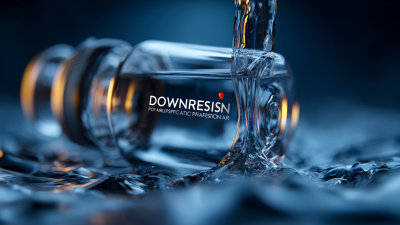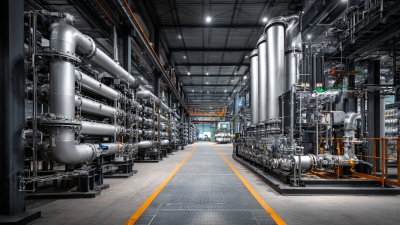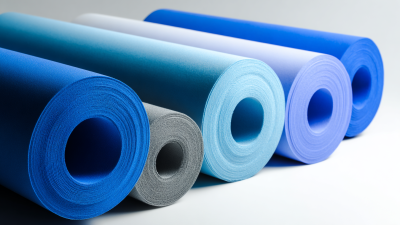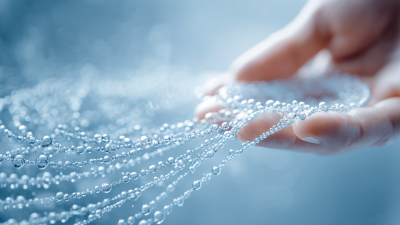Leave Your Message
Request a Quote
 Downstream processing plays a pivotal role in the
biopharmaceutical industry, focusing on the
purification and formulation of biological products. As highlighted in a recent report by
Grand View Research, the global
downstream processing market is projected to reach USD 26.58 billion by 2027,
growing at a CAGR of 11.1% from 2020. This increasing demand underscores the
importance of efficient downstream processing techniques to ensure product quality and compliance
with stringent regulatory standards. With the rise of personalized medicine and advanced
biotherapeutics, mastering downstream processing has become crucial for beginners entering this field.
Understanding the fundamentals of this complex process not only enhances production efficiency but
also significantly impacts the economics of therapeutic development. As we unlock the secrets of
downstream processing, we aim to equip newcomers with the knowledge necessary to navigate this
dynamic landscape successfully.
Downstream processing plays a pivotal role in the
biopharmaceutical industry, focusing on the
purification and formulation of biological products. As highlighted in a recent report by
Grand View Research, the global
downstream processing market is projected to reach USD 26.58 billion by 2027,
growing at a CAGR of 11.1% from 2020. This increasing demand underscores the
importance of efficient downstream processing techniques to ensure product quality and compliance
with stringent regulatory standards. With the rise of personalized medicine and advanced
biotherapeutics, mastering downstream processing has become crucial for beginners entering this field.
Understanding the fundamentals of this complex process not only enhances production efficiency but
also significantly impacts the economics of therapeutic development. As we unlock the secrets of
downstream processing, we aim to equip newcomers with the knowledge necessary to navigate this
dynamic landscape successfully.
Downstream processing (DSP) is a critical phase in bioprocessing that focuses on the purification and recovery of biological products, such as proteins, antibodies, and vaccines. Understanding the foundational concepts and terminology is essential for anyone entering this field. Key processes in DSP include filtration, chromatography, and precipitation, each designed to separate desired products from impurities and contaminants. According to a recent report by Grand View Research, the global downstream processing market is expected to reach $33.36 billion by 2028, growing at a CAGR of 12.7%, highlighting the increasing importance and investment in this area.
Filtration techniques, such as microfiltration and ultrafiltration, are often the first steps in DSP, utilized to remove cells and large debris. Following this, chromatography techniques—like affinity, ion-exchange, and size-exclusion chromatography—play a pivotal role in achieving the required purity levels. A study by the BioPharma Research Group pointed out that up to 80% of the total processing time is spent on downstream activities, underlining the need for efficiency and innovation in this segment. By mastering these key concepts and terminologies, beginners can position themselves effectively in the rapidly evolving biomanufacturing landscape.
Downstream processing is a critical phase in bioprocessing that focuses on the recovery and purification of biomolecules. As a beginner, understanding essential techniques in this area can significantly enhance your expertise and efficiency. Key methods include filtration, chromatography, and precipitation, which are integral for isolating products from complex mixtures. According to a report by Grand View Research, the global downstream processing market is projected to reach $42.6 billion by 2027, indicating robust growth fueled by advancements in biotechnology and pharmaceuticals.
For beginners looking to build a toolkit for downstream processing, mastering these techniques is crucial. Filtration, for instance, is widely used for separating solid materials from fluids, while chromatography serves as a powerful method for separating chemical compounds based on their interactions with stationary and mobile phases. It’s vital to familiarize yourself with various chromatography techniques, such as affinity and size-exclusion chromatography, as highlighted in industry reports. Furthermore, the integration of automation in downstream processing is becoming increasingly prevalent, enhancing efficiency and reproducibility. Understanding these foundational elements can empower beginners to navigate the complexities of downstream processing with confidence.
This chart illustrates various downstream processing techniques and their associated processing times in hours. Understanding these techniques is crucial for optimizing production in bioprocessing.
Downstream processing is a critical phase in the biopharmaceutical production chain, often fraught with challenges that can impede efficiency and product quality. One common hurdle is the optimization of purification techniques, which involves balancing yield and purity. Many beginners may struggle with selecting the right chromatography methods or filtration processes, leading to suboptimal results. It is essential to understand the characteristics of the target product and contaminants, as this knowledge allows for informed choices in method selection and parameter adjustment.
Another significant challenge is scale-up from laboratory to industrial scale. Variability in conditions can occur, affecting the performance of purification processes and leading to increased costs or reduced yields. To mitigate this, incorporating robust process development strategies, such as Design of Experiments (DoE), is vital. This approach enables practitioners to systematically evaluate and optimize variables before scaling, ensuring more predictable and reliable outcomes. Additionally, continuous training and staying updated with technological advancements can empower beginners to navigate these challenges effectively, ultimately enhancing the efficiency of downstream processing.
Choosing the right equipment for effective downstream processing is crucial for optimizing production efficiency and product quality in biomanufacturing. Downstream processing involves a series of steps to isolate and purify biological products, which typically includes filtration, chromatography, and drying processes. Each step necessitates specific equipment tailored to the nature of the product and the desired purity level. For instance, membrane filtration systems are ideal for initial separation tasks, while high-performance liquid chromatography (HPLC) is often used for more refined purification.
When selecting equipment, it's important to consider the scalability of the technology. Equipment that can be easily scaled up or down allows for flexibility during development and production phases. Additionally, assessing the compatibility of the equipment with existing systems is vital to ensure seamless integration. Beyond functionality, factors such as cost, maintenance requirements, and ease of operation should also be taken into account to ensure a practical and efficient downstream processing workflow. Investing in the right tools not only enhances the overall success of processing but also contributes to the sustainability of production practices.
Downstream processing is a critical phase in the bioprocessing industry, encompassing the purification and recovery of biological products. To optimize downstream processing efficiency, one of the best practices is to implement continuous monitoring throughout the process. By utilizing real-time data analytics, operators can detect deviations and make necessary adjustments immediately, reducing waste and improving yield. This proactive approach not only enhances the overall robustness of the process but also minimizes downtime, making production more efficient.
Another best practice is the integration of advanced purification techniques such as membrane filtration and chromatography. These methods can significantly reduce the number of steps required in downstream processing, thereby cutting operational costs. Furthermore, the selection of appropriate resins and membranes specific to the target product can lead to higher purity levels and better recovery rates. Training staff on these innovative techniques and keeping abreast of industry advancements is essential for maintaining an efficient downstream processing pipeline. Empowering the workforce with knowledge ensures that the operation remains competitive and capable of adapting to new challenges in the bioprocessing landscape.







